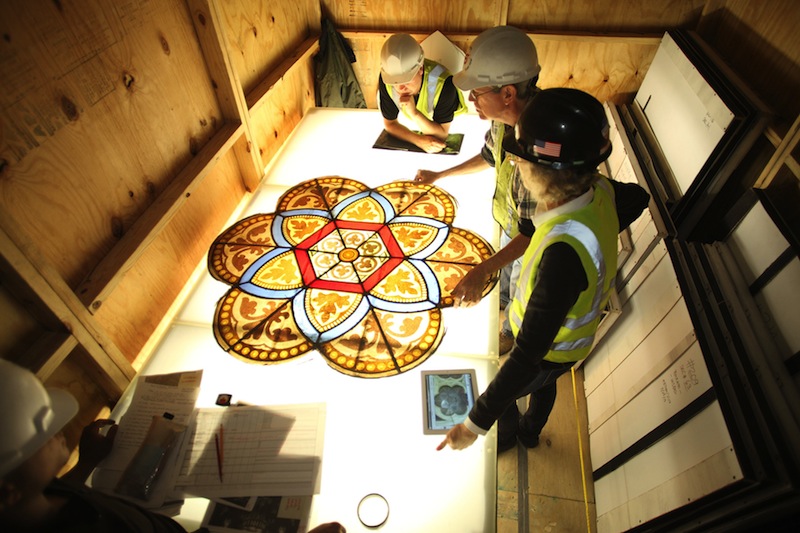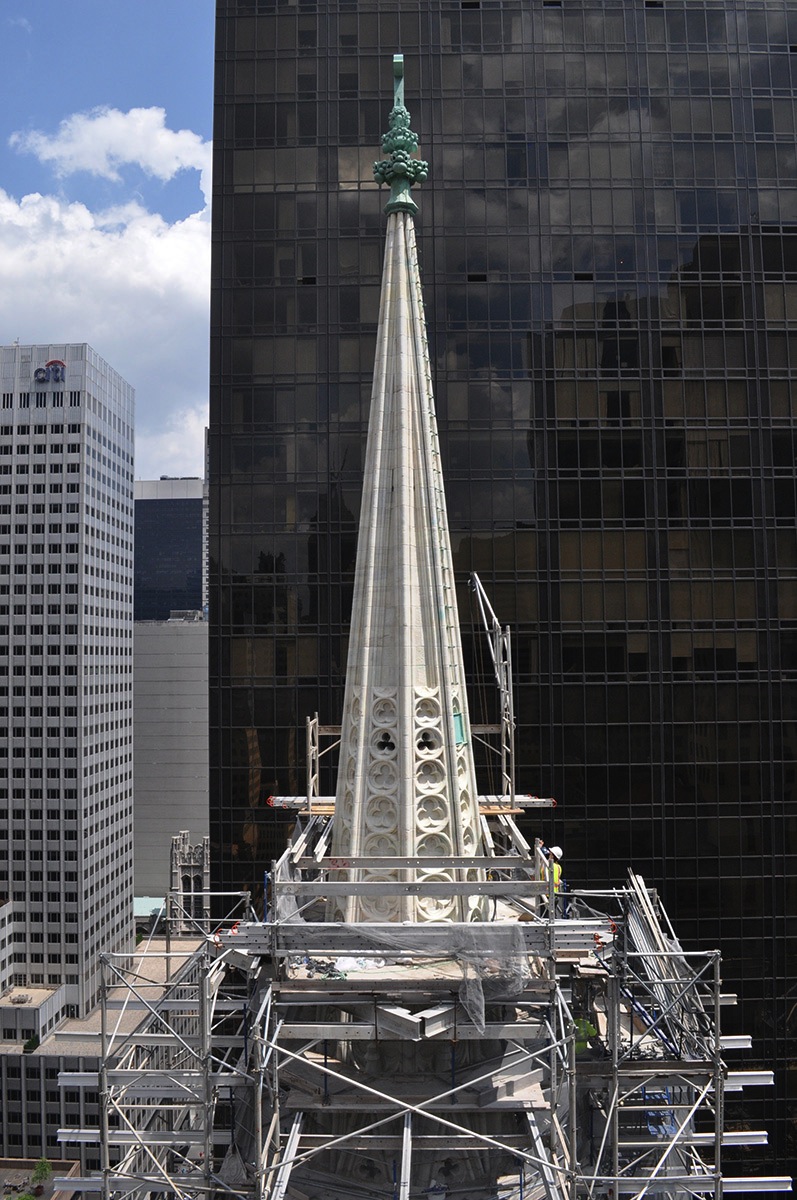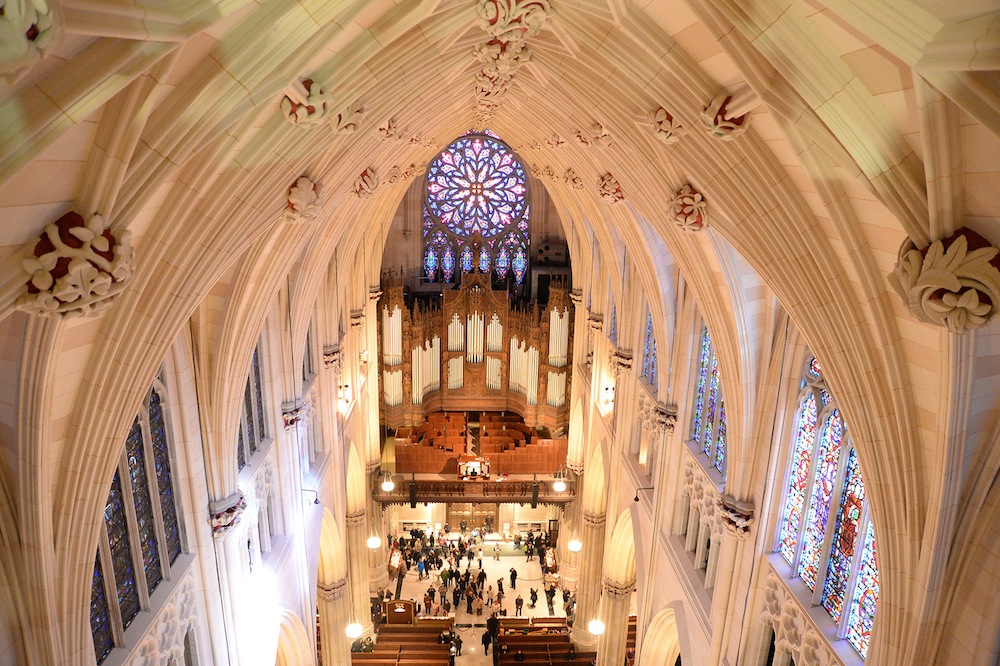Pope Francis is scheduled to visit New York City next month, and one of his stops will be the Cathedral of St. Patrick, where the Pontiff will lead an evening prayer service called Vespers on September 24.
Just in time for the Holy Father’s arrival, the neo-Gothic Roman Catholic Church and landmark in Manhattan will have completed a $177 million restoration, whose planning and reconstruction took nearly nine years. The complexity of this project required an unusually diverse array of consultants, from the Metropolitan Museum of Art to the New York Fire Department.
St. Patrick’s, which opened in 1888, had fallen into serious disrepair when, in 2006, Cardinal Edward Egan called for the building’s first major overhaul in 70 years. Murphy Burnham & Buttrick Architects developed a master plan that would allow the cathedral to stay open during the restoration.
A complex scaffolding system on a rolling platform moved down the cathedral’s interior nave in phases. That movement was coordinated, when possible, with exterior scaffolding to access stained glass windows from both sides and allow the Design team to review surfaces while the church was in use.
Autodesk’s BIM360 Field software managed this project, whose construction work got started in 2012 and included the tracking of more than 30,000 preservation treatments and repairs. This software also allows changes to the project’s scope to be communicated instantly to the Building Team.

Every square inch of the exterior was cleaned and repaired, including the twin spires that rise 330 feet about street level. On the exterior, stone was cleaned using the Rotec system, a micro-abrasive technology of low-pressure water, air, and crushed glass. Copper stains were removed with a clay poultice that draws impurities from the stone. On the interior, the team used multiple applications of Arte Mundit, a chemical cleaning latex peel.
Seventy-five stained glass windows with 3,700 panels were cleaned and repaired, too. The team installed new transparent protective glazing with laminated UV filtering, which let in more light and mitigated heat.
Because there was no system for putting out a fire in the attic above the nave except for a single standpipe, it was clear that a blaze in the attic would be too dangerous for firefighters to extinguish. So the team installed a high-pressure mist system as an alternative to a conventional sprinkler system. The system uses nitrogen to propel a small fraction of the water a conventional sprinkler system uses, suppressing a fire in minutes.
All new MEP and electrical systems are installed, including a geothermal system that required drilling 10 wells of up to 2,200 feet deep into the bedrock along the north and south sides of the Cathedral, a feat considering the network of subways, plumbing, and infrastructure underground. The geothermal system is expected to provide a 30% energy savings and reduce greenhouse gas emissions by 94,000 kilograms annually.
The Building Team included Building Conservation Associates (Restoration Consultant), Landmark Facilities Group (MEP Engineer), Silman Associates (Structural Engineer), Langan (Geotechnical Engineer), Robin Key (Landscape Architecture), Jaffe Holden Acoustics, Aramark, Arup Fire, Barkley Studio, Cerami & Associates, William Dailey Code Consulting, Construction Specifications, Inc., Ducibella Venter & Santore, Eckersley O’Callaghan & Partners, Femenella & Associates, Fisher Marantz Stone, Mary Kay Judy, GB Geotechnics, Heintges & Associates, Northeast Energy Services, PW Grosser Consulting, Slocum Cost Consulting, and VDA Associates.

Related Stories
| Apr 16, 2014
Upgrading windows: repair, refurbish, or retrofit [AIA course]
Building Teams must focus on a number of key decisions in order to arrive at the optimal solution: repair the windows in place, remove and refurbish them, or opt for full replacement.
| Apr 9, 2014
Steel decks: 11 tips for their proper use | BD+C
Building Teams have been using steel decks with proven success for 75 years. Building Design+Construction consulted with technical experts from the Steel Deck Institute and the deck manufacturing industry for their advice on how best to use steel decking.
| Apr 2, 2014
8 tips for avoiding thermal bridges in window applications
Aligning thermal breaks and applying air barriers are among the top design and installation tricks recommended by building enclosure experts.
| Mar 31, 2014
Extreme conversion: Soaring Canadian church transformed into contemporary library
Even before the St. Denys-du-Plateau Church was converted into a library, it was an unusual building, with a towering nave designed to mimic a huge tent inflated by the wind.
| Mar 26, 2014
Callison launches sustainable design tool with 84 proven strategies
Hybrid ventilation, nighttime cooling, and fuel cell technology are among the dozens of sustainable design techniques profiled by Callison on its new website, Matrix.Callison.com.
| Mar 20, 2014
Common EIFS failures, and how to prevent them
Poor workmanship, impact damage, building movement, and incompatible or unsound substrate are among the major culprits of EIFS problems.
| Mar 12, 2014
14 new ideas for doors and door hardware
From a high-tech classroom lockdown system to an impact-resistant wide-stile door line, BD+C editors present a collection of door and door hardware innovations.
| Feb 6, 2014
First Look: Center for Hope will welcome world's religious to Jerusalem
The space, backed by The Elijah Interfaith Institute, is meant to "bring about world-changing peace and harmony."
| Jan 28, 2014
16 awe-inspiring interior designs from around the world [slideshow]
The International Interior Design Association released the winners of its 4th Annual Global Excellence Awards. Here's a recap of the winning projects.
| Jan 13, 2014
Custom exterior fabricator A. Zahner unveils free façade design software for architects
The web-based tool uses the company's factory floor like "a massive rapid prototype machine,” allowing designers to manipulate designs on the fly based on cost and other factors, according to CEO/President Bill Zahner.

















